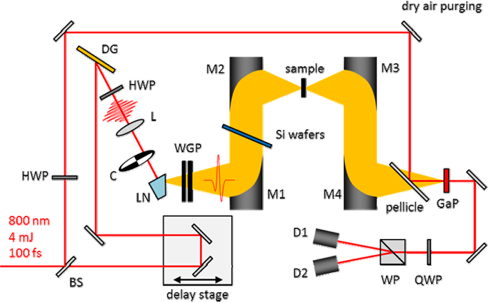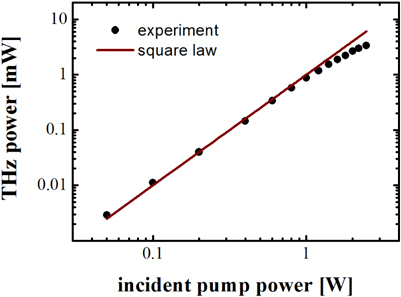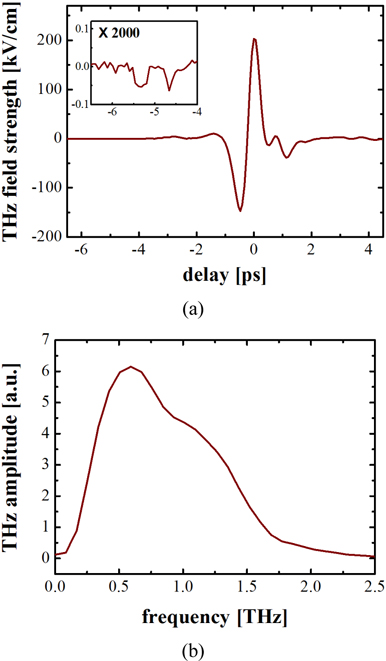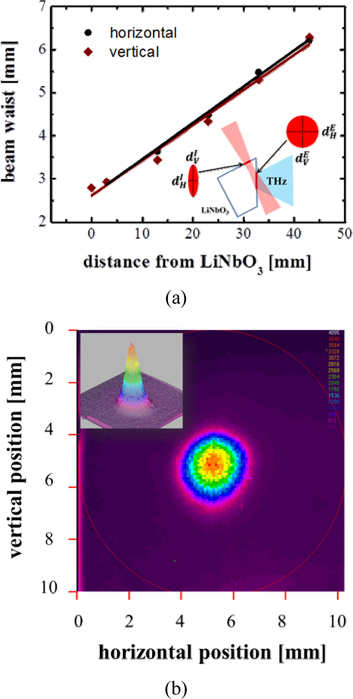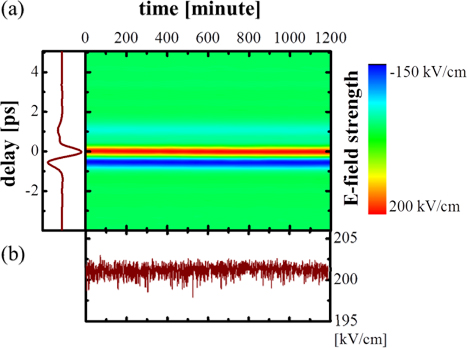



Ultrashort electromagnetic radiation in the frequency region between 0.1 and 10 THz is of great interest for a variety of applications, such as optical spectroscopy, biomedical imaging, communications, and security systems [1-3]. In particular, studies on terahertz (THz) nonlinear phenomena in various materials, often require intense ultrashort THz pulses with microjoule-level energy and electric field strength of >100 kV/cm, are currently regarded as an unexplored new research area [4-7]. Since the availability of compact high-power ultrashort THz sources is quite limited yet, development of such sources is an essential step for advanced nonlinear spectroscopy and applications in the THz frequency range. There are different methods to generate ultrashort THz pulses depending on the desired frequency range and the purpose of applications. Thanks to both technical advances in femtosecond laser systems and photoconductive (PC) antennas based on semiconductor materials, several generation techniques are wellestablished for single-cycle THz pulse generation in the frequency range around 1 THz. The PC antenna-based THz emitters are widely used for THz time-domain spectroscopy (THz-TDS) to find molecular fingerprints of matters and to extract their optical constants [8]. Although such THz-TDS systems exhibit an excellent signal-to-noise ratio (SNR, ratio of the peak-to-peak signal amplitude and the root-meansquare noise amplitude) of >100000:1 in the temporal THz waveform [9], achievable THz pulse energies are limited and cannot exceed 1 μJ because of the limited illumination of excitation pulses on the PC antenna [10]. In last decade, optical rectification in second-order nonlinear optical crystals, such as ZnTe, GaSe, and DAST, has been emerging as an efficient alternative method for generating more intense single-cycle THz pulses. However, the magnitude of the THz pulse energy is often limited by several factors, such as absorption, phonon resonances, and photorefractive damages in nonlinear crystals [11, 12]. In addition, the group velocity of the ultrashort optical excitation pulses has to be well-matched to the phase velocity of the newly generated THz pulses in the nonlinear medium for efficient frequency conversion [13].
Lithium niobate (LiNbO3) is a well-known nonlinear optical crystal and a potential candidate for efficient THz wave generation due to its large second-order nonlinear coefficient (deff = 168 pm/V). The relatively large band-gap (Eg = 3.8 eV) of LiNbO3 allows us to use near-infrared excitation sources without two-photon absorption [14]. However, the large index dispersion and mismatch in LiNbO3 inhibit efficient phase matching in a collinear geometry. Since Hebling
II. DESIGN OF EFFICIENT PHASE MATCHING BY TILTED PULSE-FRONT EXCITATION
For THz pulse generation, we used a 1-kHz Ti:sapphire regenerative amplifier (Spitfire Ace, Spectra Physics), delivering 4-W average output power with pulse duration of 100 fs at 800 nm, as the excitation source. Figure 1 shows the schematic configuration of a high-power THz pulse generation and detection system. This system can be further used for THz-TDS. The optical beam was divided by a 92:8 beam splitter for THz generation and detection.
The tilting angle (γ) of the pump pulse-front was controlled by an Au-coated diffraction grating (1800 grooves/mm) and a lens of 150-mm focal length using the following relation: where
The horizontal (
Figure 2 shows the generated THz average power versus the incident pump power, measured at the sample position of Fig. 1. The THz average power increased quadratically with increasing pump power. Above pump powers of 800 mW, the experimental data began to deviate slightly from the square-law curve (solid line). This might be mainly caused by the occurrence of free carrier absorption of THz pulses in LiNbO3 [19]. In the pulse-front-tilted excitation scheme with combination of grating-lens-LiNbO3, we were able to generate intense THz pulses with average powers up to 3.3 mW with 2.4-W pumping. Once the pump power exceeded 2.45 W, the photorefractive effect was observed in the crystal and this led to a slight decrease of the conversion efficiency. At a pump power of 2.4 W, the pump-to-THz energy conversion efficiency of 1.36 × 10-3 was obtained and the corresponding photon conversion efficiency was evaluated to be 74.8% by taking into account the peak frequency of 0.62 THz.
Figure 3 shows the time trace of the generated THz pulses measured at the maximum average power by electrooptic sampling and the corresponding spectrum was obtained by fast Fourier transform (FFT). The THz electric field strength is given by where
An optimal focal length of the first parabolic mirror M1 was chosen through the measurement of the THz beam divergence. As shown in Fig. 4(a), the THz beam radius from the emitter to far-field was evaluated by the knifeedge method. We found that the radially-symmetric radiation of THz beams could be easily achieved by the optimized single-lens focusing scheme. As shown in inset of Fig. 4(a) and Eq. (5), the horizontal diameter (
The half divergence angles of the THz beam at the horizontal and vertical direction were measured to be 82.54 and 81.32 mrad, respectively
Figure 4(b) shows the spatial intensity distribution of the THz beam at the focal point between the parabolic mirrors M2 and M3. The radial symmetric cross-section of the THz beam spot with a diameter of about 2 mm is clearly captured by the pyroelectric camera. The M2-factor of 1.2 measured at this position implied that the generated THz beam exhibits a nearly diffraction-limited Gaussian profile.
Figure 5 shows the measured long-term stability of our THz pulse generation system. The time-trace of the THz electric field strength was recorded during 20 hours. Neither phase shift nor temporal distortion of the electric field was observed in the THz waveform. The peak value of the electro-optic sampling signal was also measured for the same period with N = 6000 sampling. The mean value of the electric field at the maximum with a standard deviation was estimated to be 201.1±0.6 kV/cm, which corresponds to an error of only < 0.3%. Finally, we could achieve an exceptionally high SNR of about 1:15000.
We demonstrated efficient THz pulse generation in a prism-cut LiNbO3 via optical rectification based on TPFP at 800 nm. It was shown that our THz generation system can generate 3.3-mW THz pulses with electric field strength as high as 350 kV/cm and the pump-to-THz energy conversion efficiency of 1.36 × 10-3 at room temperature. We expect that such a high-power THz pulse generation system delivering nearly diffraction-limited 1-kHz THz pulses with extremely high signal-to-noise ratio (~1:15000) is very well suited for sensitive and precise THz applications in nonlinear and time-domain spectroscopy, imaging, and metrology.
